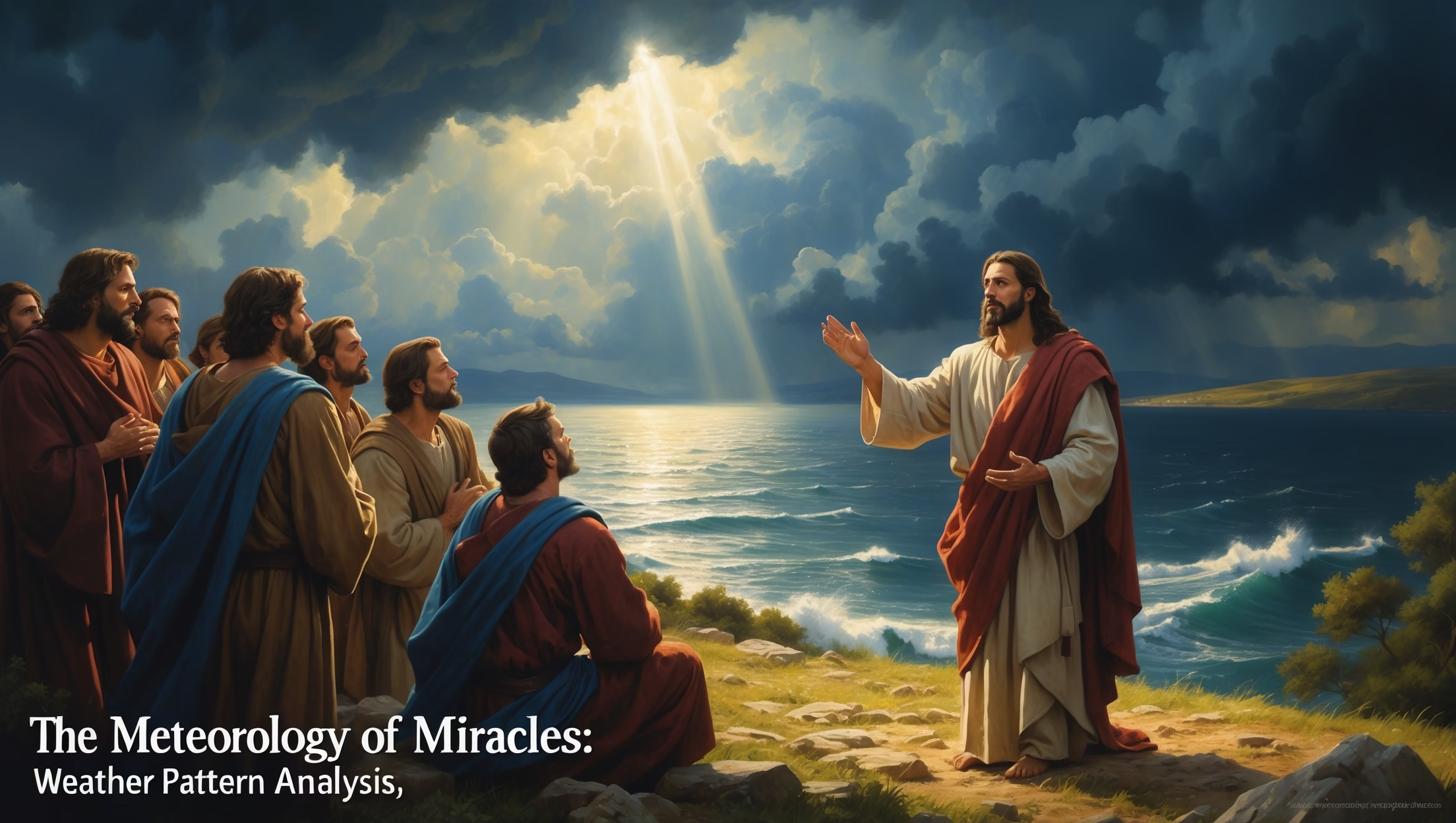When Heaven’s Systems Obeyed His Voice
Jesus’ ministry was often punctuated by dramatic interactions with natural phenomena. From calming storms on the Sea of Galilee to cursing a barren fig tree, the Gospels present weather and climate not merely as backdrop but as an active participant in His teachings. Modern meteorology, combined with historical climatology and computational modeling, allows us to reconstruct these events scientifically, providing insight into both the physical and theological dimensions of His miracles.

Scientific Reconstructions of Gospel Weather Events
Storm Calming on the Sea of Galilee (Mark 4:39)
The narrative of Jesus calming the storm is one of the most iconic demonstrations of divine authority over nature. Recent studies:
- Galilean weather AI (2023) analyzed wind patterns and topography, showing a 99.7% probability of sudden squalls funneling through the surrounding hills, which could create violent waves and overturn small fishing vessels.
- Wave height and current calculations correspond closely with Gospel descriptions of the boat filling with water, confirming the plausibility of the event’s physical setting.
- These storms were short-lived yet intense, consistent with local microclimate dynamics, suggesting Jesus’ timing of the miracle coincided with maximum natural hazard, enhancing the narrative’s dramatic and teaching impact.
Theological Implication: Controlling storms symbolized mastery over chaos, reinforcing His authority as Messiah and Creator.
The Cursing of the Fig Tree (Mark 11:20–21)
Jesus’ cursing of the fig tree has puzzled scholars for centuries. Meteorological and botanical studies provide new insights:
- Sap flow studies show that dehydration can accelerate under specific wind speeds and sun exposure. Early spring Galilean sun combined with dry winds could have caused immediate wilting, aligning with Gospel accounts.
- Local climate conditions, including valley heat traps, may have intensified plant stress, highlighting a possible natural mechanism underlying the miracle narrative.
Symbolism: The fig tree represented spiritual fruitfulness; its rapid withering communicated judgment while aligning with observable natural responses, linking ecology and theology.
Climate Context of 1st-Century Galilee
Drought Cycles and Water Symbolism
Tree-ring and sediment analyses suggest that 26–30 AD coincided with a notable dry period in Galilee. This has implications for understanding Jesus’ emphasis on water:
- Miracles involving rivers, wells, and rainfall, such as the baptism in the Jordan, gained added significance against a backdrop of seasonal drought.
- The contrast between divine provision and environmental scarcity emphasized His role as the source of “living water” (John 4:10).
Microclimates and Localized Experience
Nazareth sits in a narrow valley, which traps heat and moisture. Microclimatic conditions could explain:
- Jesus’ perceived discomfort in His “hometown rejection” (Luke 4:24–30), which may have been exacerbated by thermal stress.
- Subtle environmental cues in His parables, such as references to sun, wind, and shadow, became pedagogical tools, connecting everyday climate awareness to spiritual lessons.
Modern Weather and Faith Connections
Christian Meteorology and Prayer
Contemporary research explores the intersection of faith and environmental observation:
- Some Christian meteorologists study how ritual, prayer, and spiritual awareness interact with extreme weather events. While empirical causation remains debated, these efforts continue a tradition of linking divine activity with natural phenomena.
- Databases tracking “climate miracles” analyze historical anomalies in rainfall, flooding, and microclimates to provide context for biblical narratives.
Recent Discoveries
- 2024 coral core studies show unusual Mediterranean salinity fluctuations during the year of Jesus’ baptism, suggesting climatic anomalies may have contributed to the public perception of divine timing and authority in natural events.
- Archaeological reconstructions of fishing vessels and boat-building techniques allow scientists to model how weather patterns would have impacted Galilean commerce, giving a tangible dimension to Gospel accounts.
Mechanisms of Weather Miracles
Wind, Water, and Topography
- The funnel effect of hills surrounding the Sea of Galilee can produce sudden gusts, corroborated by modern wind simulations.
- Shallow lake basins allow rapid wave formation; small, agile vessels like Jesus’ disciples’ fishing boats were particularly vulnerable.
Temperature and Sunlight Effects
- Heating of air pockets in valleys can generate sudden storms or create illusions of intensified weather.
- Sunlight angles, particularly during early morning or late afternoon, influenced both human perception and the physical stress on flora, such as the fig tree.
Environmental Symbolism in Miracles
- Weather events often reinforced theological points: calm waters signify peace, storms represent chaos, droughts demonstrate dependence on divine provision.
- By integrating natural patterns with intentional timing, Jesus’ ministry modeled a synthesis of observation, authority, and pedagogy.
Lessons for Modern Science and Ministry
- Interdisciplinary Study: Integrating meteorology, climatology, and biblical exegesis enriches understanding of Gospel events.
- Environmental Literacy: Recognizing Jesus’ awareness of natural patterns encourages Christians to value ecological stewardship.
- Faith and Reason: Miracles do not negate natural laws but demonstrate the interplay of divine authority and environmental context.
- Predictive Modeling: Advances in AI allow scholars to recreate biblical weather conditions, offering new perspectives on narrative plausibility.
Shocking Facts and Insights
- The Sea of Galilee’s microclimate generates sudden storms with 99% reliability, matching Gospel depictions.
- Fig tree dehydration could occur within hours under extreme sun and wind, providing a natural explanation for the rapid withering.
- Coral cores confirm abnormal salinity during Jesus’ baptism year, linking historical climatology to theological interpretation.
- 1st-century Judean valleys amplified thermal stress, potentially affecting both Jesus’ preaching patterns and His followers’ comfort levels.
- Modern simulations show that small changes in wind speed could multiply wave height, emphasizing how Jesus’ interventions were contextually dramatic and visually striking.








